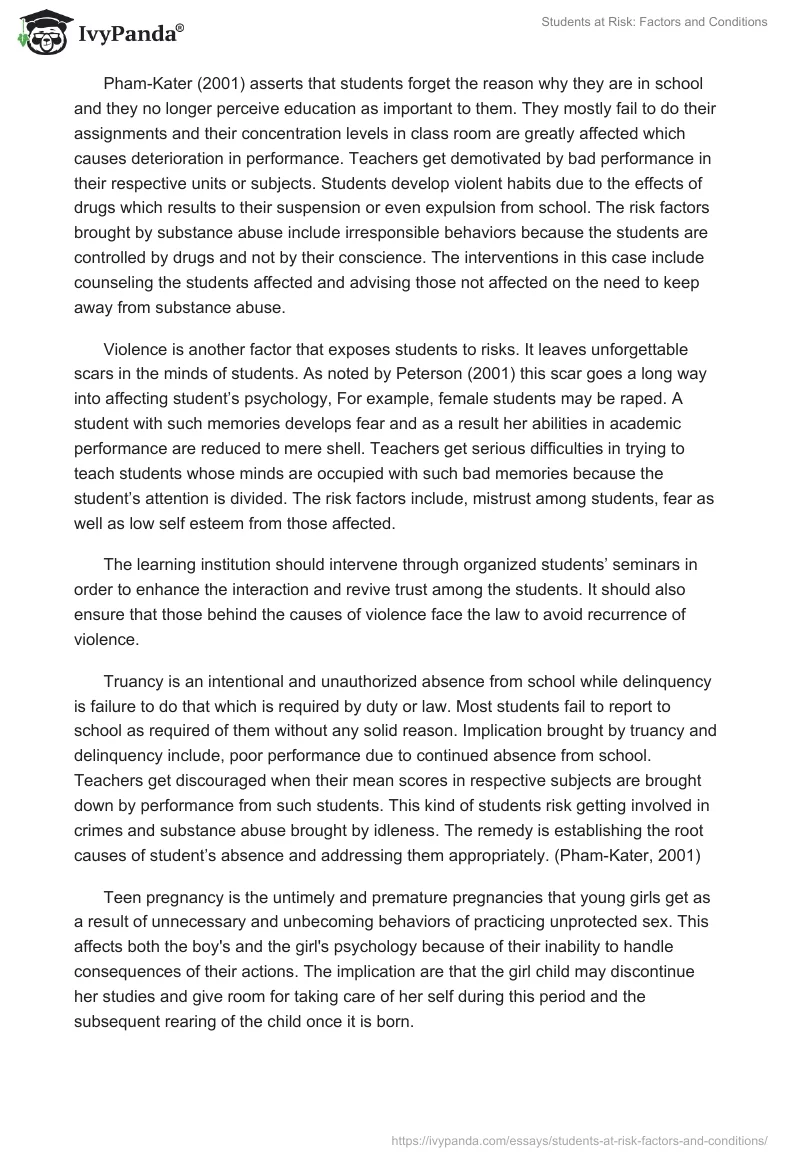There are quite a number of factors or conditions that expose students to different risks especially in their academic endeavors. Some of these factors are poverty, substance abuse, violence, truancy and delinquency and teen pregnancy. Poverty is defined as deprivation, a lack of safe drinking water and shelter or a lack of access to food. (Peterson, 2001) Factors such as harsh environment, bad economic conditions, poor health care, poor governance as well as social factors are major contributors of poverty. Students who experience these conditions lack access to health services. They also suffer from hunger, starvation and they experience both physical and mental health problems.
The implications that accrue from poverty are detrimental to a student’s education. For example, a poor student’s concentration level while in the class room is adversely affected as compared to other students from well to do families. This in return negatively affects the student’s performance and teachers might end up losing their best student as a result of this because most of them opt to drop out of school instead of being in a humiliating setting.
The risk factors brought by poverty on a students life include, loss of interest in education which causes a drop in performance. A student may also contract diseases brought by lack of enough nutrients in the body because he/she can not afford a well balanced diet. Bad health may cause prolonged absence from school which will affect a student’s performance. The remedy is that learning institutions should develop support programs which include financial as well as material help to such students.
Substance abuse is another factor that exposes students to risks. It refers to dependence and overindulgence in drugs or other chemicals that affects ones physical and mental health. According to Jeremy (2000), 40-45% of students in various schools have in one or several occasions used drugs and other harmful chemicals due to peer pressure. Implications from this habit include withdrawal symptoms which is a sign of a student’s absence from reality.
Pham-Kater (2001) asserts that students forget the reason why they are in school and they no longer perceive education as important to them. They mostly fail to do their assignments and their concentration levels in class room are greatly affected which causes deterioration in performance. Teachers get demotivated by bad performance in their respective units or subjects. Students develop violent habits due to the effects of drugs which results to their suspension or even expulsion from school. The risk factors brought by substance abuse include irresponsible behaviors because the students are controlled by drugs and not by their conscience. The interventions in this case include counseling the students affected and advising those not affected on the need to keep away from substance abuse.
Violence is another factor that exposes students to risks. It leaves unforgettable scars in the minds of students. As noted by Peterson (2001) this scar goes a long way into affecting student’s psychology, For example, female students may be raped. A student with such memories develops fear and as a result her abilities in academic performance are reduced to mere shell. Teachers get serious difficulties in trying to teach students whose minds are occupied with such bad memories because the student’s attention is divided. The risk factors include, mistrust among students, fear as well as low self esteem from those affected.
The learning institution should intervene through organized students’ seminars in order to enhance the interaction and revive trust among the students. It should also ensure that those behind the causes of violence face the law to avoid recurrence of violence.
Truancy is an intentional and unauthorized absence from school while delinquency is failure to do that which is required by duty or law. Most students fail to report to school as required of them without any solid reason. Implication brought by truancy and delinquency include, poor performance due to continued absence from school. Teachers get discouraged when their mean scores in respective subjects are brought down by performance from such students. This kind of students risk getting involved in crimes and substance abuse brought by idleness. The remedy is establishing the root causes of student’s absence and addressing them appropriately. (Pham-Kater, 2001)
Teen pregnancy is the untimely and premature pregnancies that young girls get as a result of unnecessary and unbecoming behaviors of practicing unprotected sex. This affects both the boy’s and the girl’s psychology because of their inability to handle consequences of their actions. The implication are that the girl child may discontinue her studies and give room for taking care of her self during this period and the subsequent rearing of the child once it is born.
The boy assumes fatherly responsibilities which are beyond his abilities. Deterioration of performance of the affected students is inevitable. Teachers may end up losing very good students in this habits which may reduce their willingness to work hard in their teaching careers. Students risk death especially when they contemplate abortion as the solution to their problem. Learning institutions should take both the boy and the girl through counseling sessions to reduce chances of experiencing trauma. ( American psychiatric Association, 1994)
In conclusion, the above factors do affect a student’s academic performance. They should be looked into carefully because their effects are detrimental to the student’s life and performance in school. Learning institutions should also set up facilities like counseling centers in their institutions to handle the effects and risks brought by these factors amongst their students. Failure to find the remedies to this risks that face the students may amount to disintegration of societal institutions and as a result increased vices which destabilizes proper functioning of the society.
References
American psychiatric Association (1994) Diagnostic and statistical manual of mental disorder, Washington D.C, pp. 45 -110.
Peterson, D. (2001), violence in human beings, Mariner Books pp. 46-79.
Pham-Kater, G. (2001), substance abuse and dependence, Farmington Hills: Farmington books pp. 16-59.


